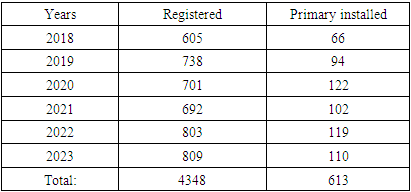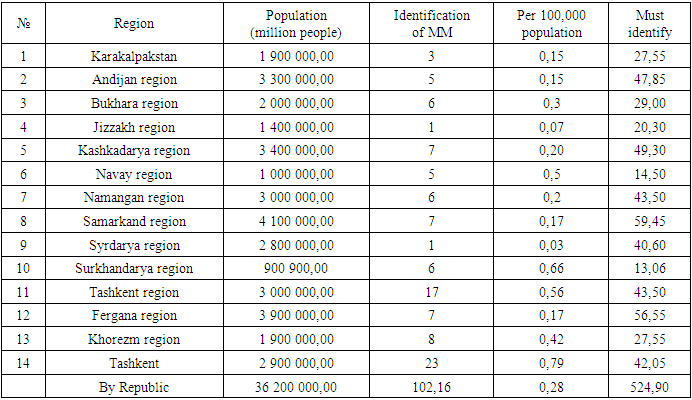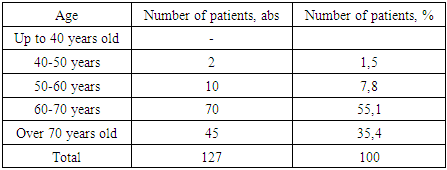-
Paper Information
- Next Paper
- Previous Paper
- Paper Submission
-
Journal Information
- About This Journal
- Editorial Board
- Current Issue
- Archive
- Author Guidelines
- Contact Us
American Journal of Medicine and Medical Sciences
p-ISSN: 2165-901X e-ISSN: 2165-9036
2024; 14(8): 2052-2056
doi:10.5923/j.ajmms.20241408.23
Received: Jul. 30, 2024; Accepted: Aug. 20, 2024; Published: Aug. 22, 2024

Analysis of Prevalence and Incidence of Multiple Myeloma in the Republic of Uzbekistan: Data and Trends
Asrarova Nigora Mirfozilovna, Azimova Sevara Bakhadirovna, Kayumov Abdurakhmon Abdumavlyanovich
Republican Specialized Hematology Scientific and Practical Medical Center, Tashkent Medical Academy, Uzbekistan
Copyright © 2024 The Author(s). Published by Scientific & Academic Publishing.
This work is licensed under the Creative Commons Attribution International License (CC BY).
http://creativecommons.org/licenses/by/4.0/

This study aims to analyze the prevalence and incidence of multiple myeloma in the Republic of Uzbekistan, taking into account different regions, age groups, and gender of the population. Epidemiological data based on the analysis of a large volume of medical records and disease statistics were utilized to achieve this goal. The researchers meticulously analyzed the distribution of multiple myeloma among the population of Uzbekistan, identifying differences in the frequency of incidence in various regions of the country, as well as differences by age and gender. The findings allowed for the identification of key trends and patterns in the prevalence of multiple myeloma, which may contribute to the improvement of strategies for the diagnosis, prevention, and treatment of this oncological disease. This study holds significant importance for practical healthcare in Uzbekistan, as its findings can serve as a basis for developing targeted programs for early detection of multiple myeloma and improving the quality of medical care for these patients. Such statistical analyses are crucial for effective control of the spread of oncological diseases and enhancing treatment outcomes for specific patient groups.
Keywords: Multiple myeloma, Disease epidemiology, Statistics, Diagnostics, Disease, Hematology, Pathology
Cite this paper: Asrarova Nigora Mirfozilovna, Azimova Sevara Bakhadirovna, Kayumov Abdurakhmon Abdumavlyanovich, Analysis of Prevalence and Incidence of Multiple Myeloma in the Republic of Uzbekistan: Data and Trends, American Journal of Medicine and Medical Sciences, Vol. 14 No. 8, 2024, pp. 2052-2056. doi: 10.5923/j.ajmms.20241408.23.
Article Outline
1. Introduction
- It is known that multiple myeloma (MM) is a B-cell lymphoproliferative malignancy characterized by plasma cells that produce a monoclonal immunoglobulin (paraprotein) [1-3]. The first documented description of MM was made by the British physician S. Solly in 1844 [4]. In 1940, Apitz discovered "proteins foreign to the blood, formed by pathological cells, with a homogeneous structure," which he called "paraproteins" [5]. In 1978, R.A. Kule and his group introduced the term "monoclonal gammopathy of undetermined significance" (MGUS), caused by the secretion of pathogenic immunoglobulins [6]. The disease has several names, including plasma cell myeloma, multiple myeloma, myelomatosis, Kahler-Rustizky disease, secreting lymphoma, generalized plasmacytoma, and elderly disease [7].The incidence of multiple myeloma (MM) accounts for approximately 1% of all malignant neoplasms and 10-13% of all hematologic malignancies. The disease is more common in individuals of non-Negroid race, less common in those of Europoid race, and even less common in those of Mongoloid race. The peak age of onset of the disease is in the sixth decade of life. MM occurs in 3-5% of cases in individuals younger than 45 years and is rare in children and adolescents. Among individuals over 60 years old, the average incidence is 37 cases per 100,000 population. The male-to-female ratio for this condition is 1.4:1. Each year, 3-5 people out of 100,000 are diagnosed with MM. In the Russian Federation, approximately 20,000 new cases of MM are diagnosed annually, with an average age of 62 years for affected individuals. The mortality rate from MM accounts for 18% of all hematologic malignancies.In Uzbekistan, numerous researchers are examining this issue, however, the epidemiology of this pathology remains inadequately understood.
2. Research Objective
- To conduct an analysis of epidemiological data to determine the prevalence of Multiple Myeloma in different regions of Uzbekistan and its distribution among the population by age and gender, in order to identify key trends and develop recommendations for improving the diagnosis, prevention, and treatment of this disease in the country.
3. Materials and Methods
- In accordance with the conclusion of the medical expert commission and regulatory acts, a clinical fragment involving 208 patients was examined. Two groups were formed based on the inclusion and exclusion criteria for this study: the 1st group consisted of 208 patients with multiple myeloma who sought examination and treatment at the Republican Specialized Scientific-Practical Medical Center for Hematology of the Ministry of Health of the Republic of Uzbekistan. Additionally, the study included the analysis of outpatient cards, medical histories, and reports from 2018 to 2023 at the Republican Specialized Scientific-Practical Medical Center for Hematology of the Ministry of Health of the Republic of Uzbekistan.
4. The Findings and Discussion of Our Own Research Results
- The current status of multiple myeloma epidemiology in Uzbekistan is inadequately studied, with only sporadic publications dedicated to this issue. In order to conduct a more comprehensive examination of the detection rate of multiple myeloma in Uzbekistan, we have focused on the following key points:1. Study of disease prevalence: Analyzing the yearly dynamics of new cases of multiple myeloma in Uzbekistan can help determine the trends in the spread of the pathology within the country.2. Regional disparities: Comparing the detection rates of multiple myeloma in different regions of Uzbekistan may reveal variations in disease distribution.3. Demographic considerations: Examining the prevalence of multiple myeloma among various age groups and gender can provide valuable insights into patterns of disease occurrence.We found detailed analytical data on the detection rate of multiple myeloma in Uzbekistan to be useful for improving strategies for the diagnosis, treatment, and control of this oncological disease in the country. An analysis of the registration indicators of primary MM patients for the years 2018-2023 was conducted by us (see Table 1). In 2020, the number of active primary MM cases was 122, and by 2023, the prevalence of the disease had increased to 809 cases (18.6% of the total number of registered primary cases).
|
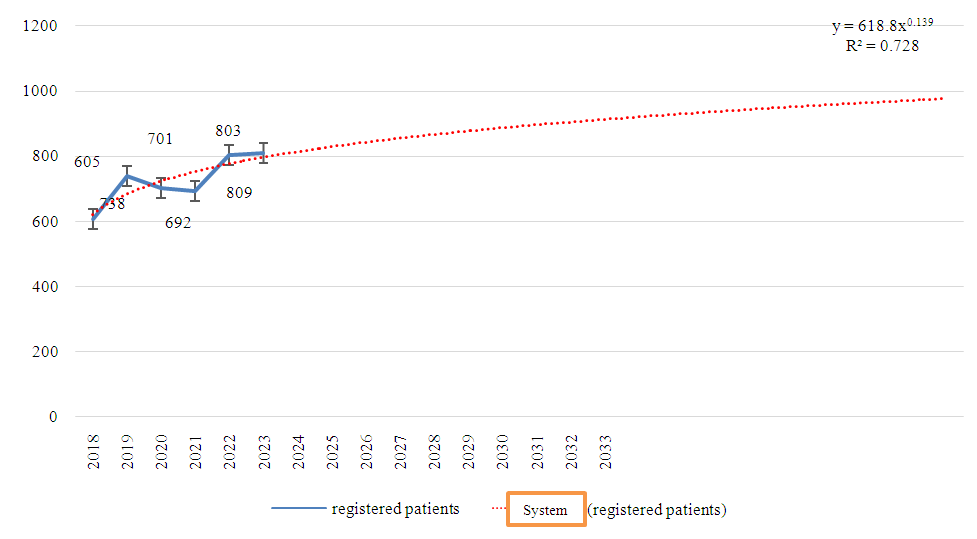 | Figure 1. Expected admission number of patients with multiple myeloma in the Republic of Uzbekistan |
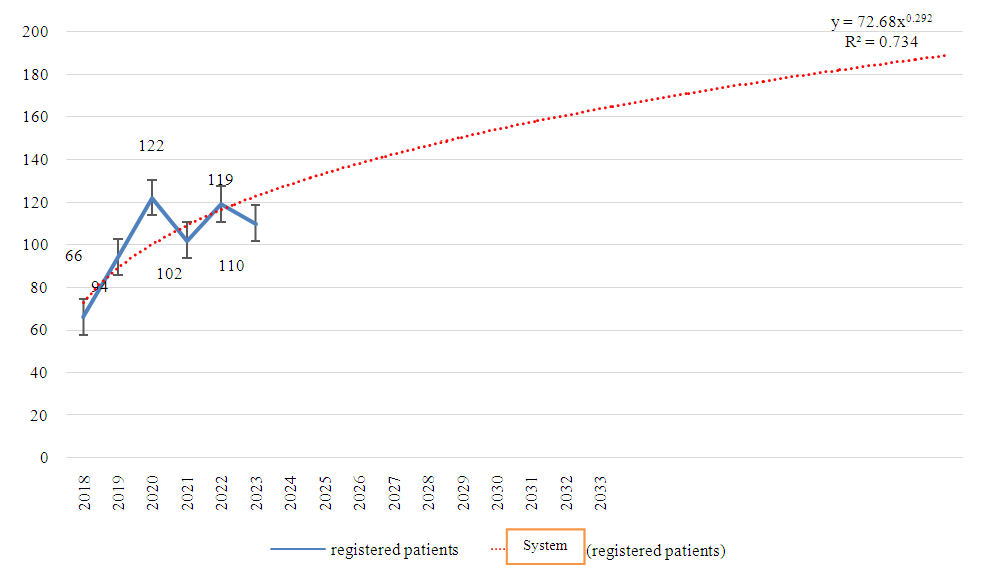 | Figure 2. Prognosis for identifying initially diagnosed patients with multiple myeloma in the Republic of Uzbekistan |
|
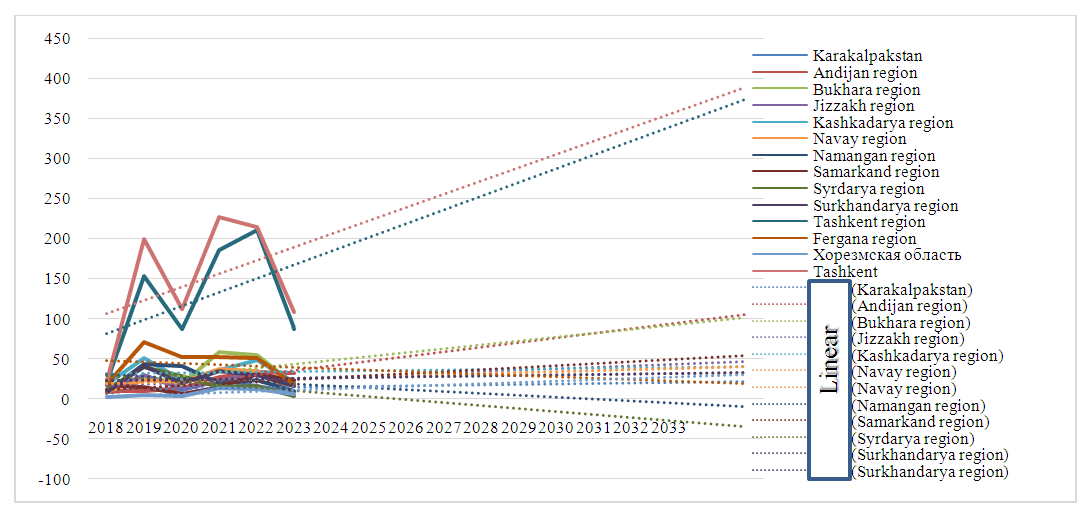 | Figure 3. Distribution of multiple myeloma cases and projected growth of the disease by regions of Uzbekistan |
|
|
5. Conclusions
- Studying the epidemiology of multiple myeloma in Uzbekistan is a necessary and important step in understanding the prevalence and characteristics of this oncological disease in the region. Having detailed data on the incidence rate in different areas, age groups, and among men and women allows for the identification of potential high-risk groups and the determination of ways to optimize diagnosis, prevention, and therapy. The results of our study emphasize the importance of further monitoring and analyzing the epidemiological indicators of multiple myeloma to improve the quality of oncological care, ensure early detection, and provide the most effective treatment for this disease in Uzbekistan and potentially develop more tailored strategies for controlling its spread.Our recommendations for further steps include the need for conducting additional research such as investigating risk factors: studying possible causes and factors influencing the occurrence of multiple myeloma in Uzbekistan could be beneficial for developing prevention strategies and more effective disease control, implementing an early detection and screening system, providing training for healthcare professionals on diagnosing and treating this type of cancer, and other measures aimed at improving outcomes in the fight against multiple myeloma in Uzbekistan.
 Abstract
Abstract Reference
Reference Full-Text PDF
Full-Text PDF Full-text HTML
Full-text HTML